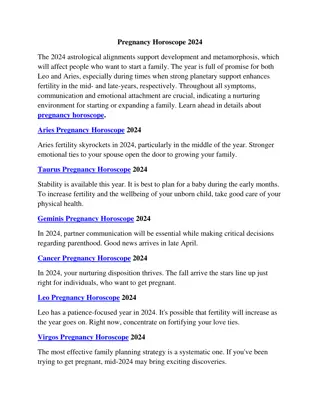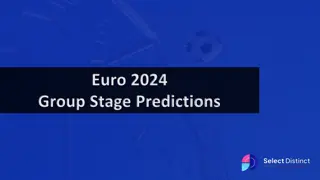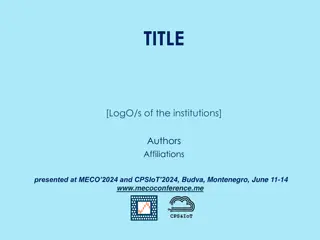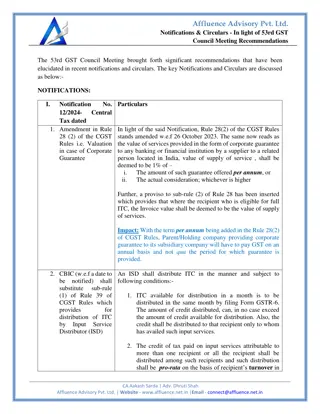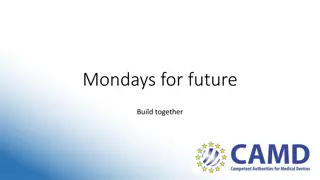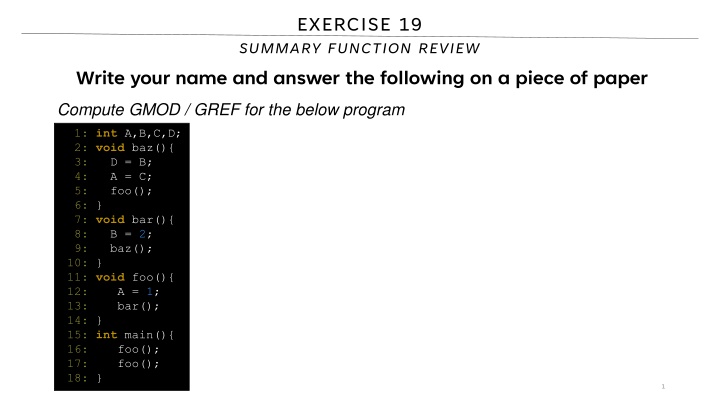
Function Review for GMOD/GREF Program
"Learn how to compute GMOD and GREF for a program involving functions and variable assignments. Understand the abstract transfer functions and analyze program behavior efficiently."
Download Presentation

Please find below an Image/Link to download the presentation.
The content on the website is provided AS IS for your information and personal use only. It may not be sold, licensed, or shared on other websites without obtaining consent from the author. If you encounter any issues during the download, it is possible that the publisher has removed the file from their server.
You are allowed to download the files provided on this website for personal or commercial use, subject to the condition that they are used lawfully. All files are the property of their respective owners.
The content on the website is provided AS IS for your information and personal use only. It may not be sold, licensed, or shared on other websites without obtaining consent from the author.
E N D
Presentation Transcript
EXERCISE 19 SUMMARY FUNCTION REVIEW Write your name and answer the following on a piece of paper Compute GMOD / GREF for the below program 1: int A,B,C,D; 2: void baz(){ 3: D = B; 4: A = C; 5: foo(); 6: } 7: void bar(){ 8: B = 2; 9: baz(); 10: } 11: void foo(){ 12: A = 1; 13: bar(); 14: } 15: int main(){ 16: foo(); 17: foo(); 18: } 1
EXERCISE 19 SOLUTION SUMMARY FUNCTION REVIEW 2
ADMINISTRIVIA AND ANNOUNCEMENTS
CALL TARGETS EECS 677: Software Security Evaluation Drew Davidson
5 LAST TIME: SUMMARY FUNCTIONS REVIEW: LAST LECTURE CANWEOVER-APPROXIMATEAFUNCTION SEFFECTWITHOUT BUILDINGTHESUPERGRAPH? Motivation Allows quick , modular analysis Manifestations GMOD/GREF (what variables are touched?) Abstract transfer functions
6 ABSTRACT TRANSFER FUNCTIONS REVIEW: LAST LECTURE CANWEOVER-APPROXIMATEAFUNCTION SEFFECTWITHOUT BUILDINGTHESUPERGRAPH?
7 OVERVIEW HOW DO WE FIGURE OUT CONTROL TRANSFER TARGETS IN THE FIRST PLACE?
LECTURE OUTLINE Dynamic Dispatch Algorithms
DYNAMIC DISPATCH A HISTORY OF COMPUTING 9 1: class A{ 2: 3: 4: }; 5: class B : public A{ 6: public String g(){ return "B"; } 7: }; 8: class C : public A{ 9: public String g(){ return "C"; } 10: }; 11: class D : public A{ 12: public String g(){ return "D"; } 13: }; 14: class Driver { 15: publicvoid main(String[] args){ 16: A[] aArr = {new A(), new B()}; 17: for (A a : aArr){ 18: A res = a.f(); 19: print(a.g()); 20: print(res.g()); 21: } 22: } 23: }; public A f(){ returnnew C(); } public String g(){ return "A"; } A.init A.f A.g Driver.main 16 B.init 18 19 20 B.g C.init C.g C.init D.g
10 DYNAMIC DISPATCH: GETS COMPLICATED! A HISTORY OF COMPUTING
11 DYNAMIC DISPATCH: GETS COMPLICATED! A HISTORY OF COMPUTING DIRECT CALLS Not so bad INDIRECT CALLS Quite a bit harder: multiple targets possible!
12 DYNAMIC DISPATCH: GETS COMPLICATED! A HISTORY OF COMPUTING 1: class A{ 2: 3: 4: }; 5: class B : public A{ 6: public String g(){ return "B"; } 7: }; 8: class C : public A{ 9: public String g(){ return "C"; } 10: }; 11: class D : public A{ 12: public String g(){ return "D"; } 13: }; 14: class Driver { 15: publicvoid main(String[] args){ 16: A[] aArr = {new A(), new B()}; 17: for (A a : aArr){ 18: A res = a.f(); 19: print(a.g()); 20: print(res.g()); 21: } 22: } 23: }; public A f(){ returnnew C(); } public String g(){ return "A"; } DIRECT CALLS Not so bad INDIRECT CALLS Quite a bit harder: multiple targets possible!
LECTURE OUTLINE Dynamic Dispatch Algorithms
14 CLASS HIERARCHY ANALYSIS (CHA) A HISTORY OF COMPUTING 1: class A{ 2: 3: 4: }; 5: class B : public A{ 6: public String g(){ return "B"; } 7: }; 8: class C : public A{ 9: public String g(){ return "C"; } 10: }; 11: class D : public A{ 12: public String g(){ return "D"; } 13: }; 14: class Driver { 15: publicvoid main(String[] args){ 16: A[] aArr = {new A(), new B()}; 17: for (A a : aArr){ 18: A res = a.f(); 19: print(a.g()); 20: print(res.g()); 21: } 22: } 23: }; CONSIDERTHE SAFEOVER-APPROXIMATION Treat call as declared type, or any subtype public A f(){ returnnew C(); } public String g(){ return "A"; } Object A f Driver main B g C g D g
15 RAPID TYPE ANALYSIS (RTA) A HISTORY OF COMPUTING 1: class A{ 2: 3: 4: }; 5: class B : public A{ 6: public String g(){ return "B"; } 7: }; 8: class C : public A{ 9: public String g(){ return "C"; } 10: }; 11: class D : public A{ 12: public String g(){ return "D"; } 13: }; 14: class Driver { 15: publicvoid main(String[] args){ 16: A[] aArr = {new A(), new B()}; 17: for (A a : aArr){ 18: A res = a.f(); 19: print(a.g()); 20: print(res.g()); 21: } 22: } 23: }; REFINEMENTOVER CHA Consider only initialized classes public A f(){ returnnew C(); } public String g(){ return "A"; } Consider only reachable code Object A f Driver main B g C g D g
16 CHA A HISTORY OF COMPUTING 1: class A{ 2: 3: 4: }; 5: class B : public A{ 6: public String g(){ return "B"; } 7: }; 8: class C : public A{ 9: public String g(){ return "C"; } 10: }; 11: class D : public A{ 12: public String g(){ return "D"; } 13: }; 14: class Driver { 15: publicvoid main(String[] args){ 16: A[] aArr = {new A(), new B()}; 17: for (A a : aArr){ 18: A res = a.f(); 19: print(a.g()); 20: print(res.g()); 21: } 22: } 23: }; REFINEMENTOVER CHA Consider only initialized classes public A f(){ returnnew C(); } public String g(){ return "A"; } Consider only reachable code Object A f Driver main B g C g D g
17 RAPID TYPE ANALYSIS (RTA) A HISTORY OF COMPUTING RTA = call graph of functions (initially edgeless) CHA = call graph via class hierarchy analysis W = worklist W.push(main) while not W.empty: M = pop W T = allocated types in M T = T U allocated types in RTA callers of M foreach callsite(C) in M if C is statically-dispatched: add edge C to C s static target else: M = methods called from M in CHA M = M intersect functions declared in T or T-supertypes add edge from M to each M W.pushAll(M )
18 RAPID TYPE ANALYSIS (RTA) A HISTORY OF COMPUTING ANUNSOUNDANALYSIS! 1: publicstatic Object gbl; 2: 3: publicstaticvoid main(String[] args){ 4: foo(); 5: bar(); 6: } 7: 8: publicstaticvoid foo(){ 9: Object o = new A(); 10: gbl = o; 11: } 12: 13: publicstaticvoid bar(){ 14: gbl.toString(); 15: } RTA will not include an edge from bar to toString because neither bar or its callers (main) allocated any instance that toString could be called on
19 RAPID TYPE ANALYSIS (RTA) A HISTORY OF COMPUTING ANUNSOUNDANALYSIS! 1: publicstatic Object gbl; 2: 3: publicstaticvoid main(String[] args){ 4: Object o = foo(); 5: bar(o); 6: } 7: 8: publicstatic Object foo(){ 9: returnnew A(); 10: gbl = o; 11: } 12: 13: publicstaticvoid bar(Object o){ 14: o.toString(); 15: } Call edge to A s toString missing! Neither bar or its callers (main) allocated a type of A
20 BEYOND RTA A HISTORY OF COMPUTING ASSUMPTIONSTOSTRENGTHENANALYSIS Type safety? Might not be a safe assumption FTA adds the constraint that any method that reads from a field can inherit the field- compatible allocated types of any method that could write to that field. MTA adds the constraint that types allocated in a method and then passed to a method through a parameter should be compatible with the called method s parameter types. MTA also adds the constraint that the return type of each called method be added to the set of allocated types. XTA: add both the constraints of MTA an FTA
21 COMPARING CALL GRAPH ANALYSES A HISTORY OF COMPUTING CHA Complete Edge-finder RTA Precision Efficiency FTA MTA XTA
















